savor
Mindful Eating, Mindful Life
savorthebook.com
Read More About
Mindful Eating
Mindful Living
Weight Loss
Exercise
Meditation
More Than Exercise, Yoga is Union
A note from Lilian:
Yoga and mindfulness are intimately intertwined. I find great value in the practice of yoga, and I know many of our community members do as well. I asked Marti Yura, a yoga teacher and studio owner, to share with us the most important lesson she's learned so far as a yogi.
~
For me, the ultimate take-away from yoga is the experience of interconnectedness with all things and the understanding that everyone and everything matters. As a yoga teacher and studio owner, yoga and its various practices have become a blueprint to live my life by. It has helped me design and create my life and given me the tools to deal with even the most difficult situations.
In western culture, most people think of yoga as postures or another form of exercise. But with its rich traditions and philosophies, it is so much more. The Sutras of Patanjali are the building blocks from which the practice of yoga has sprung. It’s described as “the eight-fold path” or eight limbs. Sutra, meaning thread, is the earliest record of the teachings that were passed down from generation to generation. Woven into the very fabric of life. The word yoga, loosely translated, means a state of “union.”
As a science, yoga has been shown to both heal and prevent certain maladies. The yogis discovered that by placing the body in postures that both work with and against gravity, holding for an appropriate length of time - with focus on sensation, alignment and breath - you can achieve the experience of integration. The postures can strengthen, lengthen and realign muscles and bones, as well as improve heart and lung functions. Studies continue to show that with consistent practice, over time, there is a significant reduction of cortisol - a stress hormone that attacks the joints, muscles and immune system.
In a simple pose like downward facing dog, as I spread my palms and press my hands into the earth, I can feel my spine lengthen, my sits bones lift, the back of my legs broaden and my heels descend. As I take a deep breath, relaxing my neck and face, there’s a felt sense that the bottom of my toes connect to my eye brows and I feel my body alive! The key here, and what makes it yoga, is this integration of body, breath and focus of mind in the present moment.
The earliest yogis practiced asana, or postures, to allow the body and mind to become still for meditation. In that stillness a process called self-realization occurs. The self recognizes itself as eternal and non-dualistic. In yoga we call this state Samadhi: integration, wholeness, or truth.
When we experience this state of oneness or union, we actually come into alignment with our higher self, our hearts’ deeper purpose.
You too can achieve this state of union, through a regular practice of yoga. Let’s begin with this simple series:
Standing Chest Opener:
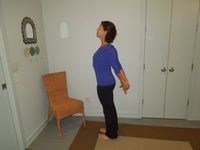
Stand with weight evenly distributed into both feet. Draw hands behind your back and clasp. On inhalation, as you press firmly into your feet, shoulders move back and down. As arms extend and lengthen, thighbones move slightly back and tailbone lengthens down.
Standing Chair Twist:
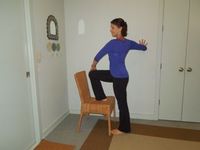
Place right foot on chair, right hand to wall and left hand to outside of the right knee. Inhale and press into left foot, drawing tailbone down and lifting up through your spine. Exhale and turn navel, belly then shoulders to the right, gaze to the left. Continue to breathe 4-5 more breaths. Reverse to left.
Standing Downward Facing Dog:
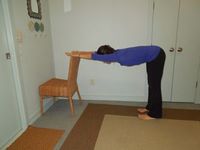
Place hands on the back of a chair or on the top of a desk or counter. Walk feet back far enough to extend arms fully and lengthen spine. With feet directly under hips. Inhale, breathing into shoulders and chest. Exhale, firming the abdominals into the front spine. Hold for 5 breaths.
Standing Half Moon:
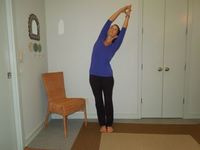
Place feet side by side or slightly apart. Inhale, press into feet, arms reach overhead coming into a clasp. Exhale and bend to the right. Keep weight in feet, pull tailbone down and draw the ribs in. Hold for 3-5 breaths. Switch sides.
Chair Warrior:
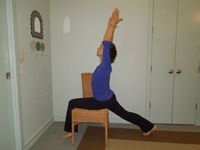
Hold on to the back of the chair, step your right foot forward over the seat of the chair and onto the floor. Square hips and shoulders to the side of the seat. Stretch through the back foot. On inhalation, lift up out of the pelvis, stretching the sides of the waist up as arms reach overhead. Keep low back lengthening down. Hold 5 breaths. Change sides.
Seated Forward Fold:
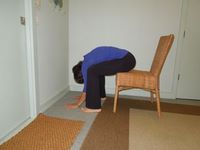
Sit towards the front of the chair and inhale, lifting up through spine. Then exhale and fold forward. Breathe into your belly and low back. Exhale and relax as you fold forward. Let the tension drain out the crown of your head. Stay for 5-10 breaths.
Seated Meditation:

Sit upright with your weight placed evenly on both sits bones. Align your ears and shoulders over hips. Palms rest on the thighs. Inhale fully through the nose, into your abdomen, chest and back. Noticing a slight pause at the top of the breath, exhale slowly through the nose, pressing the abdomen in and slightly up. Following the sensation of the breath as it exits. Listen and feel. Notice the pause at the end of that cycle. Continue to breath and observe sensation. Begin with 5 minutes and increase up to 20 minutes daily.
SAVOR: Mindful Eating, Mindful Life. Copyright © 2025 by Thich Nhat Hanh and Lilian Cheung. All Rights Reserved. Please review our terms of use
Website design
Mary Pomerantz Advertising




